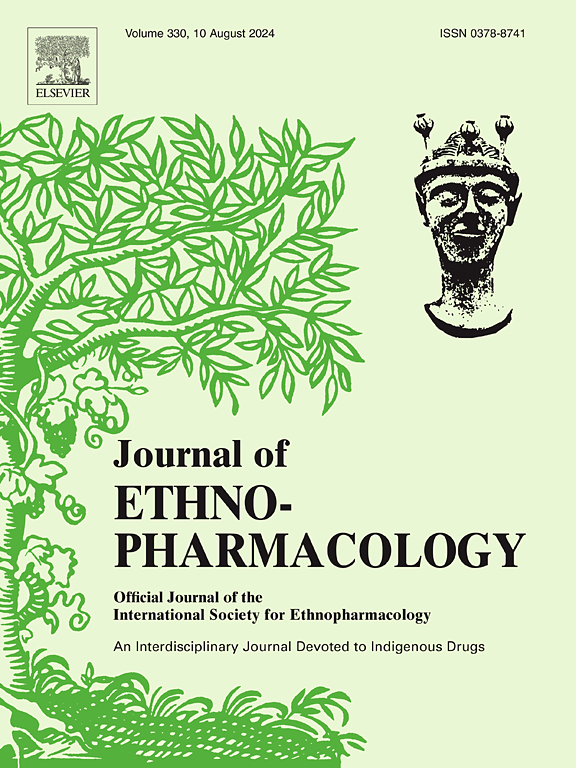石斛提取物调节整合素α ib β3介导的信号通路,抑制血小板活化和血栓形成。
IF 4.8
2区 医学
Q1 CHEMISTRY, MEDICINAL
引用次数: 0
摘要
民族药理学相关性:石斛。是一种很有发展前途的药用植物。具有活血化瘀、调节经络的传统药用功效。研究目的:研究丹参提取物参与血小板活化和血栓形成的机制,并利用网络药理学和分子对接分析阐明其潜在机制。材料与方法:采用聚集仪检测丹参提取物对血小板聚集和ATP释放功能的影响;流式细胞术检测丹参提取物对PAC-1、纤维蛋白原与整合素结合的影响;通过血小板黏附、扩张和凝块缩回检测丹参提取物对血小板“由外向内”信号的影响;通过网络药理学和分子对接分析血小板与DNL提取物相互作用的关键化合物和主要靶点,并通过western blotting对相关途径蛋白进行验证;采用肠系膜动脉栓塞模型,观察丹参提取物对血栓形成的影响。结果:丹参提取物可抑制血小板功能,抑制PAC-1和纤维蛋白原与整合素α ib β3的结合。此外,在不影响小鼠尾部凝血时间和止血时间的情况下,可延缓fecl3诱导的肠系膜动脉血栓形成。Western blot检测血小板“内向外”和“外向内”信号,进一步证实了DNL提取物对血小板活化的抑制作用。结论:丹参提取物可能通过抑制整合素αⅡbβ3介导的双向信号通路蛋白抑制血小板活化,从而影响血栓形成过程。本文章由计算机程序翻译,如有差异,请以英文原文为准。

Dendrobium nobile lindl extract modulates integrin αIIbβ3-mediated signaling pathways to inhibit platelet activation and thrombosis
Ethnopharmacological relevance
Dendrobium nobile Lindl. (DNL) is a promising medicinal plant. It has the traditional medicinal effects of promoting blood circulation and resolving stasis, as well as regulating the meridians and collaterals.
Aim of the study
We studyed how DNL extract was involved in platelet activation and thrombosis and used network pharmacology and molecular docking analysis to help clarify the underlying mechanisms.
Materials and methods
The effect of DNL extract on platelet aggregation and ATP release function was examined by aggregometer; The effect of DNL extract on the binding of PAC-1 and fibrinogen to integrin was determined by flow cytometry; The effect of DNL extract on “outside-in” platelet signals was detected by platelet adhesion, spreading and clot retraction; Key compounds and major targets of platelet interactions with DNL extract were analyzed by network pharmacology and molecular docking and verified against related pathway proteins by western blotting; The effect of DNL extract on thrombosis was tested by mesenteric artery embolism model.
Results
DNL extract exhibited inhibition of platelet function and PAC-1 and fibrinogen binding to integrin αIIbβ3. In addition, it delayed FeCl3-induced mesenteric artery thrombosis without affecting the clotting time and the hemostatic time of tail in mice. The detection of platelet “inside-out” and “outside-in” signaling by Western blot further confirmed the inhibitory effect of DNL extract on platelet activation.
Conclusions
DNL extract may affect the thrombosis process by inhibiting platelet activation via inhibiting integrin αⅡbβ3-mediated bidirectional signaling pathway proteins.
求助全文
通过发布文献求助,成功后即可免费获取论文全文。
去求助
来源期刊

Journal of ethnopharmacology
医学-全科医学与补充医学
CiteScore
10.30
自引率
5.60%
发文量
967
审稿时长
77 days
期刊介绍:
The Journal of Ethnopharmacology is dedicated to the exchange of information and understandings about people''s use of plants, fungi, animals, microorganisms and minerals and their biological and pharmacological effects based on the principles established through international conventions. Early people confronted with illness and disease, discovered a wealth of useful therapeutic agents in the plant and animal kingdoms. The empirical knowledge of these medicinal substances and their toxic potential was passed on by oral tradition and sometimes recorded in herbals and other texts on materia medica. Many valuable drugs of today (e.g., atropine, ephedrine, tubocurarine, digoxin, reserpine) came into use through the study of indigenous remedies. Chemists continue to use plant-derived drugs (e.g., morphine, taxol, physostigmine, quinidine, emetine) as prototypes in their attempts to develop more effective and less toxic medicinals.
 求助内容:
求助内容: 应助结果提醒方式:
应助结果提醒方式:


